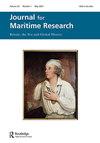‘My young Tasmanian cousin’: animal lives and companions on board and beyond the Flying Squadron, 1869–1873
Q3 Arts and Humanities
引用次数: 0
Abstract
ABSTRACT Recent scholarship has drawn attention to the complexity of animal–human relationships on board ships, but we still know relatively little about crewmembers’ responses to animals on board nineteenth-century British warships, especially on overseas voyages. The 1869–70 Flying Squadron voyage provides a useful case study. On board each of the squadron’s six warships sailed dozens of officers, hundreds of sailors and a fluctuating number of live animals. This article focuses on the Flying Squadron diary of Midshipman Marcus McCausland, plus accounts and memoirs by fellow crewmembers, which discuss animals’ shipboard role, but also reflect on naval personnel's relations with one another as well as civilians. The last section of the article considers McCausland’s service and death while serving in anti-slavery patrols off East Africa as recorded in memoirs and official correspondence. These sources reveal McCausland as a complex, ambivalent figure, whose relationship with animals, women, naval authority, and, later, slavers and the enslaved in East Africa, speaks to larger tensions over masculine and naval authority, and naval memory, in the nineteenth-century global maritime world. As well, the sources reveal the continuing importance of human companionship and memorialisation in sustaining shipboard communities.“我年轻的塔斯马尼亚表兄”:1869-1873年,飞行中队内外的动物生活和同伴
最近的学术研究已经引起了人们对船上动物与人类关系复杂性的关注,但我们对19世纪英国军舰上的船员对动物的反应仍然知之甚少,尤其是在海外航行中。1869 - 1870年飞行中队的航行提供了一个有用的案例研究。该中队的六艘军舰上,每艘都有数十名军官、数百名水手和数量不定的活体动物。本文主要关注海军军官士官生马库斯·麦考斯兰(Marcus McCausland)的飞行中队日记,以及其他船员的叙述和回忆录,其中讨论了动物在船上的角色,但也反映了海军人员之间以及平民之间的关系。文章的最后一部分考虑了麦考斯兰在东非反奴隶制巡逻时的服役和死亡,这些记录在回忆录和官方信件中。这些资料表明,麦考斯兰是一个复杂而矛盾的人物,他与动物、女性、海军权威,以及后来与东非奴隶和被奴役者的关系,反映了19世纪全球海洋世界中男性和海军权威以及海军记忆之间更大的紧张关系。此外,这些资料还揭示了人类的陪伴和纪念在维持船上社区中的持续重要性。
本文章由计算机程序翻译,如有差异,请以英文原文为准。
求助全文
约1分钟内获得全文
求助全文
来源期刊

Journal for Maritime Research
Arts and Humanities-History
自引率
0.00%
发文量
0
期刊介绍:
The Journal for Maritime Research ( JMR ), established by the National Maritime Museum in 1999, focuses on historical enquiry at the intersections of maritime, British and global history. It champions a wide spectrum of innovative research on the maritime past. While the Journal has a particular focus on the British experience, it positions this within broad oceanic and international contexts, encouraging comparative perspectives and interdisciplinary approaches. The journal publishes research essays and reviews around 15-20 new books each year across a broad spectrum of maritime history. All research articles published in this journal undergo rigorous peer review, involving initial editor screening and independent assessment, normally by two anonymous referees.
 求助内容:
求助内容: 应助结果提醒方式:
应助结果提醒方式:


